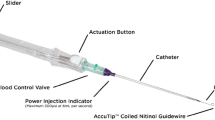Abstract
Background
Catheter rupture during CT angiography has prompted policies prohibiting the use of electronic injectors with peripherally inserted central venous catheters (PICCs) not only for CT but also for MRI. Consequently, many institutions mandate hand injection for MR angiography, limiting precision of infusion rates and durations of delivery.
Objective
To determine whether electronic injection of gadolinium-based contrast media through a range of small-caliber, single-lumen PICCs would be safe without risk of catheter rupture over the range of clinical protocols and determine whether programmed flow rates and volumes were realized when using PICCs for contrast delivery.
Materials and methods
Experiments were performed and recorded using the Medrad Spectris Solaris EP MR Injection System. PICC sizes, contrast media and flow rates were based on common institutional protocols.
Results
No catheters were damaged during any experiments. Mean difference between programmed and delivered volume was 0.07 ± 0.10 mL for all experiments. Reduced flow rates and prolonged injection durations were observed when the injector’s pressure-limiting algorithm was triggered, only in protocols outside the clinical range.
Conclusion
PICCs commonly used in children can withstand in vitro power injection of gadolinium-based contrast media at protocols significantly above clinical levels.


Similar content being viewed by others
References
Bowen A, Carapetis J (2011) Advances in the diagnosis and management of central venous access device infections in children. Adv Exp Med Biol 697:91–106
Vo JN, Hoffer FA, Shaw DW (2010) Techniques in vascular and interventional radiology: pediatric central venous access. Tech Vasc Interv Radiol 13:250–257
Chemaly RF, de Parres JB, Rehm SJ et al (2002) Venous thrombosis associated with peripherally inserted central catheters: a retrospective analysis of the Cleveland Clinic experience. Clin Infect Dis 34:1179–1183
King DS, da Cruz E, Kaufman J (2010) A model for a nurse-led programme of bedside placement of peripherally inserted central catheters in neonates and infants with congenital cardiac disease. Cardiol Young 20:302–307
Donnelly LF, Emery KH, Brody AS et al (2001) Minimizing radiation dose for pediatric body applications of single-detector helical CT: strategies at a large Children’s Hospital. AJR 176:303–306
Brenner DJ, Elliston CD, Hall EJ et al (2001) Estimates of the cancer risks from pediatric CT radiation are not merely theoretical: comment on ‘point/counterpoint: in x-ray computed tomography, technique factors should be selected appropriate to patient size. against the proposition. Med Phys 28:2387–2388
Brenner D, Elliston C, Hall E et al (2001) Estimated risks of radiation-induced fatal cancer from pediatric CT. AJR 176:289–296
Jou LD, Rapp J, Saloner D (2004) Transport of contrast agents in contrast-enhanced magnetic resonance angiography. Magn Reson Imaging 22:495–504
Morasch MD, Collins J, Pereles FS et al (2003) Lower extremity stepping-table magnetic resonance angiography with multilevel contrast timing and segmented contrast infusion. J Vasc Surg 37:62–71
Salis AI, Eclavea A, Johnson MS et al (2004) Maximal flow rates possible during power injection through currently available PICCs: an in vitro study. J Vasc Interv Radiol 15:275–281
Coyle D, Bloomgarden D, Beres R et al (2004) Power injection of contrast media via peripherally inserted central catheters for CT. J Vasc Interv Radiol 15:809–814
Kaste SC, Young CW (1996) Safe use of power injectors with central and peripheral venous access devices for pediatric CT. Pediatr Radiol 26:499–501
Herts BR, Cohen MA, McInroy B et al (1996) Power injection of intravenous contrast material through central venous catheters for CT: in vitro evaluation. Radiology 200:731–735
Ramasethu J (2008) Complications of vascular catheters in the neonatal intensive care unit. Clin Perinatol 35:199–222
Sanelli PC, Deshmukh M, Ougorets I et al (2004) Safety and feasibility of using a central venous catheter for rapid contrast injection rates. AJR 183:1829–1834
Rigsby CK, Gasber E, Seshadri R et al (2007) Safety and efficacy of pressure-limited power injection of iodinated contrast medium through central lines in children. AJR 188:726–732
Macha DB, Nelson RC, Howle LE et al (2009) Central venous catheter integrity during mechanical power injection of iodinated contrast medium. Radiology 253:870–878
Acknowledgments
Research support and contrast medium were provided by Bracco Diagnostics (Princeton, NJ, USA). The catheters and PICCs used for testing were provided by Covidien (Mansfield, MA, USA), AngioDynamics (Latham, NY, USA) and Teleflex Medical (Research Triangle Park, NC, USA). Electronic injection system, logger software and technical support were provided by MedRad (Warrendale, PA, USA).
Author information
Authors and Affiliations
Corresponding author
Rights and permissions
About this article
Cite this article
Moriarty, J.M., Kung, G.L., Ramos, Y. et al. Injection of gadolinium contrast through pediatric central venous catheters: a safety study. Pediatr Radiol 42, 1064–1069 (2012). https://doi.org/10.1007/s00247-012-2397-z
Received:
Revised:
Accepted:
Published:
Issue Date:
DOI: https://doi.org/10.1007/s00247-012-2397-z




